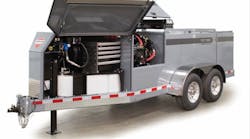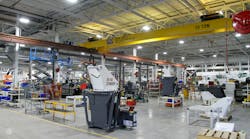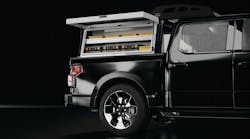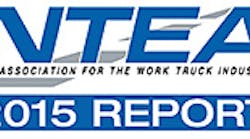BOB Aquaro has spent his entire career—43 years—in the commercial motor vehicle and contact engineering industries.
He has seen the “good, the bad, and the ugly” in commercial vehicle applications over the years. And so his presentation, “Keys to Developing a Proper Truck Chassis Spec’,” was designed to help others avoid the problems he so frequently has seen.
“A truck in the shop is a useless truck,” he said. “When spec’ing a truck chassis, take the time to think out exactly what the needs are. Your ability to think is a great asset. Take your time, make a list. Measure twice; cut once.
The ultimate goal for any truck equipment distributor is to provide a completely satisfying ownership experience for the customer. To achieve it, the new chassis must be matched to both the second unit—the truck body and equipment—and the end application. When the chassis is too small, is overloaded, there are certification and maintenance issues, and poor reliability. When the chassis is too large, there’s an excessive initial cost, a weight penalty, and higher-than-necessary fuel consumption.
“If there are incorrect options, there could be unplanned modification costs, upfitter delays, and high long-term maintenance costs. An unsuitable frame could be too weak or too heavy. An improperly selected powertrain means poor performance, high fuel consumption and expense, and increased maintenance and operating costs.”
He said matching the chassis to the application assures owner satisfaction because of increased productivity and reliability, reduced operating costs, reduced maintenance costs, extended vehicle life, and improved safety.
“Don’t guess—develop the complete package,” he said. “Follow a logical process. Research. Don’t buy an incorrect chassis and then try to make it work. Don’t make a decision based on what everyone else is doing, but do look at trends. Don’t assume that what worked in the past will meet your current needs or be correct.”
His 11 key steps:
• Ask questions.
“Don’t assume anything. Prepare a list of intelligent questions ahead of time. Interview the owner, operator, driver, user—someone close to the truck. Start with a clean sheet of paper, even if you have habits. Look, touch, smell. Use all of your senses. Write it down. Take notes. Stay awake.”
• The truck chassis selection process.
“Define chassis application requirements. Make a preliminary chassis selection and preliminary payload and weight distribution analysis. Verify the suitability of the preliminary chassis selection.
“Don’t overload the chassis. Gross Vehicle Weight Rating (GVWR) is the maximum total vehicle weight, measured at the tire-ground interfaces, for which the vehicle possesses components adequately rated to safely carry. It cannot exceed the sum of all gross axle weight ratings. It usually goes the other way. Gross axle weight ratings exceed GVWR.
“Don’t overload the axles. The Gross Axle Weight Rating (GAWR) is the value specified by the vehicle manufacturer as the load-carrying capacity of a single axle system, as measured at the tire-ground interfaces. If one axle is overloaded, the whole truck is overloaded.
“Don’t exceed the chassis capability. The Gross Combined Weight Rating (GCWR) is the maximum allowable weight of a combination vehicle at the ground with a trailer or trailers including vehicle, equipment, driver, fuel, and payload—everything that moves with the vehicle. The truck must be able to stop … as well as go.
“Don’t overload the chassis. This is essential. No one is exempt from compliance with Federal Motor Vehicle Safety Standards and/or Federal Motor Carrier Safety Administration Regulations. You may be exempt from highway loading limits but you cannot overload the chassis.
“Is the required GVW rating available? The GVW rating is typically less than the sum of GAWRs. The rating can be limited by the chassis manufacturer, frame, wheelbase, foundation brakes, engine and/or transmission selection, axle ratio, and payload distribution allowance.
“Ask: Are the required GAWRS available? Axle ratings must match or exceed maximum calculated loads: What about a snow plow or a reefer? Tire and suspension component ratings must match or exceed axle ratings to utilize full capacity of axles. The frame rating may restrict usable axle capacity ratings.”
He said in the chassis selection process, there are many considerations: payload/equipment weight; gross vehicle weight rating; wheelbase; axle capacities/auxiliaries; cab-to-axle dimension; axle spread; and weight distribution. There are chassis options (fuel tanks, DEF, batteries), component interference issues (review body builder drawings of the actual chassis), trailer/towing requirements, PTO requirements, and tax issues.
A checklist: spec final chassis components; verify chassis component weights/locations; and do a final weight distribution analysis.
• Define the application.
“That involves the operating environment and maintenance environment, and the projected/desired life cycle of the application. What about on-road/non-road operation? Length of highway runs? Grades encountered? Duty cycle?
“There are performance criteria: special equipment requirements; unique body requirements/mounting; PTO operating cycle/duty cycle; electrical interface; idle limiting; and fuel tanks. And green truck considerations. What new technologies have been introduced since my last purchase?
“Define the design constraints: overall weight; dimensions; environmental; contractual; regulatory; and financial/cost/tax.”
• Will it certify?
“Comply with the chassis OEM’s upfitting requirements and the Incomplete Vehicle Document (IVD) and body builders guide. These documents specify the OEM’s requirements for completing the vehicle with a pass-through certification, define allowable and prohibited modifications, and provide guidelines and recommendations for mounting second-unit components on a chassis.
“If the final manufacturer of a vehicle complies with all of the requirements established by the chassis OEM, the original certification will pass-through to the completed vehicle. If the vehicle is not completed within the guidelines established by the incomplete vehicle OEM, the final manufacturer must independently certify the completed vehicle. Chassis OEMs must certify that an incomplete vehicle, as originally built, complies with all applicable standards. Chassis OEMs provide guidelines for final manufacturers, or upfitters, to follow when completing a vehicle. It’s located in truck chassis cab. Read it.
“The final-stage manufacturer of a vehicle must certify that the vehicle, as completed, complies with all applicable federal standards. A vendor who modifies a previously completed vehicle must certify that the modified vehicle still conforms to applicable standards and/or that no safety devices have been rendered inoperative, such as a snowplow.
• Is the required frame available?
“Chassis OEMs establish minimum frame ratings based on GVWR, GAWR and wheelbase. Equipment vendors will require minimum frame requirements for mounting of equipment such as cranes or aerial lifts. Is the required frame available? The frame is the most important selection in the ‘sophisticated truck’ application. All dimensions of the final application are first based on the frame of the truck. What do we want this frame to be?
“Is the required or desired frame available? Frames are rated by their section modulus and by the yield strength of the frame material, usually steel. The section modulus is a measure of frame strength and rigidity as determined by the shape, material thickness, flange width and depth of the frame—expressed in cubic inches. Section modulus is not the same throughout the length of the truck frame. Published section modulus is the strongest part of the frame, usually just behind the cab. Other sections may be lower, or on rare occasion higher, than the published area. Section modulus affects weight.
“Yield strength is the maximum load that can be applied to a material without it being permanently deformed—expressed in pounds per square inch (PSI). The RBM rating of a frame is useful for comparing frames with different section modulus and yield strength ratings. Yield strength is not tensile strength. Be careful. Most all OEMs publish yield strength. Some publish tensile strength that will be a numerically higher number than yield strength.
“The Resistance Bending Moment (RBM) is the maximum bending moment that a frame can support without permanent deformation. The RBM of a frame is equal to the section modulus multiplied by the material yield strength, not tensile. The RBM rating of a frame is useful for comparing frames with different section modulus and yield strength ratings. If necessary, can the frame be reinforced at a critical point? Check with OEM when this question arises. Examples: a crane mounted at the rear of the truck or a crane mounted behind the cab.
• Know the chassis before you order it.
• Develop a preliminary payload and weight distribution analysis.
“ID weight and dimensional data for preliminary chassis selection: wheelbase/CA dimension; front axle to back of cab dimension; what’s directly behind the cab; cab-to-body dimension; passenger seating data; and chassis weight on front and rear axles.
“Verify net payload capacity. Subtract the weight of the selected chassis and all permanently installed components—body, special equipment, etc—from the chassis GVW rating to ensure the unit will have an adequate net payload capacity to meet requirements.
“Complete a preliminary weight distribution analysis. Using data from layout drawing and chassis information, determine the location of horizontal CG, in relation to the front axle, for each discrete component. Multiply the weight of each component by distance from the front axle to determine the component’s moment. Sum the moments and divide by total weight to determine H-CG for total unit. The NTEA can provide training for weight distribution analysis and frame alteration. Tara CVCS can spec your truck for you, or do an asset analysis of a customer’s existing fleet.”
• Verify suitability of preliminary chassis selection.
“Are the GVWR/GAWRs OK? Are the required GCWR and trailing weight rating available? Brakes OK? Required/desired frame? Desired powertrain?”
• Are the proper powertrain components available?
“The powertrain should be designed to work together to provide the desired performance without being over- or under-sized. Critical performance factors: starting gradeability; reserve gradeability; geared road speed; and demand road speed.
“Are the proper powertrain components available? Typical factors that impact vehicle performance: gross weight; frontal cross section, high-speed operation; aerodynamics; rolling resistance of tires; driveline efficiency; ad nominal road conditions.
“Powertrain issues and considerations: engine torque and horsepower ratings—the torque and horsepower curves tell the story; engine RPM at critical rating points; transmission availability—type, gear ranges, ratings, PTO compatibility; and final differential availability.
• Final chassis specifications.
“Spec the chassis, ensuring that all support system considerations are addressed to include: electrical system; cooling system; fuel system; brake system, including auxiliary systems; exhaust system; and PTO provisions.
“Fuel efficiency and green truck considerations: use low rolling resistance tires whenever possible; use synthetic lubricants; control the vehicle weight; consider aerodynamics when selecting and placing components; and consider slowing the truck down.
“Other fuel efficiency options: E-PTOs/solar power sources; auxiliary hotel load management; high-efficiency accessories; Auxiliary Power Units (APUs); idle control systems; and telematics systems, with routing, maintenance optimization, and driver performance.
“Fuel-efficient tires improve fuel economy by as much as 7%. SmartWay-certified tires have a minimum 3% fuel economy improvement. Should you consider single wide base tires? They have a significant weight reduction and low rolling resistance. Fuel-efficient tires that are under- or over- inflated are not fuel efficient.
“Vehicular electrical systems, when not treated knowledgeably, can cause continuing frustration. Technicians must be familiar with modern electrical systems and must not attempt to interface with these systems if they are not well-trained and well-versed.
“Rules of thumb: alternators must be sized to the job at hand; minimum battery ratings should be in the 650 to 750 CCA range for gasoline engines and in the 1900 to 2200 CCA range for diesel engines—1400 CCA combined for light-duty diesels; batteries must be protected from excessive heat, vibration and dirt; battery relocation must be well thought out and not for convenience only; LED lights reduce maintenance and limit current draw, so use caution when the application is a turn signal, and the flasher must accommodate the low current draw of an LED or a rapid flash rate may result; specify a standard sealed wiring harnesses on all bodies and equipment; and specify that all ground connections must be made at OEM-provided grounding points.
“Take advantage of OEM offerings such as integrated switches and relay-controlled power routing. Always use OEM-provided body builder electrical connections. Utilize OEM multiplexing and telematics provisions to the greatest extent possible. Offerings and capabilities vary by OEM.”
He said upgraded cooling systems (both engine and transmission) are low-cost options that are highly desirable for vocational vehicles.
• Final chassis specification.
“Spec the chassis, ensuring that all non-functional considerations are addressed to include: driver/operator retention; resale value (NPV); driver/operator skill; operator training/service technician training.
“Make a final weight distribution analysis. Repeat the weight distribution analysis, incorporating all of the options and accessories added to the base vehicle: fuel tanks; additional batteries; spare wheels/tires; and other accessory items. Take the finished product to a scale and weigh it. Make sure that you are where you wanted to be all along. Deliver the truck with deliberate care. Explain, instruct, show. Discuss: overloading, the #1 cause of premature chassis failures; maintenance importance, the #1 cause of high operating cost; and safety, including workers’ compensation and liability. Document everything.” ♦










